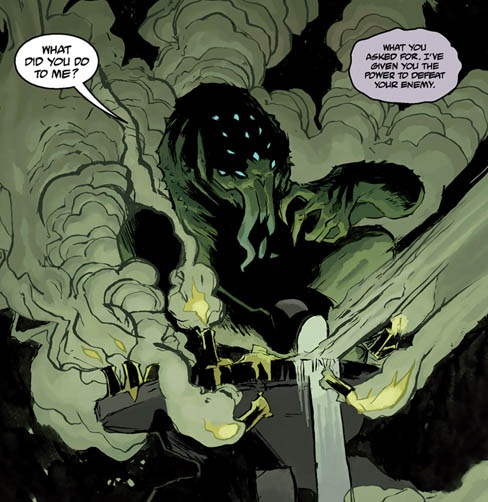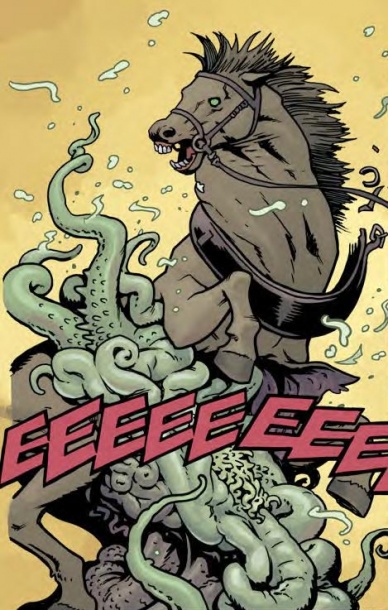
We’ve got a special treat for you today: a special mini-Hell Notes that tie directly into our review of “Hellboy and the B.P.R.D.: 1952” #4. So, check out our review, and then read the Hell Notes!

Written by Mike Mignola and John Arcudi
Illustrated by Alex MaleevAfter an explosion sends Hellboy into the sewers, he finds himself lost below a Portuguese fortress. But when he finds the way out, he stumbles into something even more ominous.
David: The penultimate issue is here, and Mike Mignola, John Arcudi and Alex Maleev deliver the chapter that pulls the curtain back on the story quite a little bit. Brian, as we’re nearing the end, how are you feeling about this mini-series?
Brian: Well, this issue was a bit of a tricky one, in terms of getting an overall tone: half the issue is playing catch up with Hellboy history, and half is a battle between the Bureau and some half-baked reanimated felons. As someone who has recently embarked on a “Hellboy” re-read, the flashback stuff felt excessive to me, but I completely understand why it is necessary. So, for me, the latter half of the issue dragged on quite a bit, but I absolutely loved the first half.
What did you think?
David: Well, on one hand, I’m a bit confused on the differences between our reads – I only remember there being like…2 or 3 pages of flashbacks dedicated to showing Von Klempt’s skepticism on Ragnarok and Rasputin’s plan, which fit what they were doing – but on the other, I also didn’t love the issue. The art was incredible, as per usual, but as with a lot of these minis the Mignolaverse does, this one feels like it’s tailing off as it approaches its end. This issue is all Archie and Hellboy dealing with Von Klempt’s big plan, and while much of it is pretty good young Hellboy business, it all feels like a pretty generic supervillainy version of Hellboy overall.
Von Klempt has another plan the team is going to foil. There are super monkeys involved, like there always is with Von Klempt. It’s Hellboy and one other teammate fighting the good fight. It feels like all of a sudden the comic transitioned into Conqueror Worm Lite, which is fun but also removes some of the creepy, unexpected elements of what made the first three issues feel special.
Despite quality craftsmanship, this felt pretty been there, done that, in a way.
Brian: True, the only “true” flashbacks are on three pages, but his entire appearance is a bit of a recap on who he is and what he is all about. None of that felt particularly revelatory, and like I said, having just re-read that in the last year or so, the backend of the book really dragged.
But you’re right about the pacing, too – the 5 issue arcs tend to always have these aces first few issues, and then a lull hits, and it wraps up nicely, and I feel that big time right here.
As you mentioned, the art by Maleev is exquisite, and his Mignola impression during the flashbacks was uncanny. As much as I love fighting monkeys (and I love fighting monkeys), I could watch the Hellboy/Fauxensteins fight all day long. I loved seeing the genesis of him using his right hand in unique ways, and he and Archie are a really fun pairing; it was nice seeing ‘Holy Crap!’ come from Archie, which would be eventually adopted by Red himself.
David: One of the things this issue did for me was it got me wondering what’s next for the universe. I mean, we have a sort of Frankenstein connection here and we have Herman Von Klempt coming back as a reminder of who he is for those who a) may not remember Conqueror Worm well or b) haven’t read it, but we know his head is rolling around somewhere after Rise of the Black Flame. Do you think this is the tip of the iceberg for Von Klempt’s return? It seems to me that it’d be a natural transition point to his resurrection of sorts (or as resurrected as a head in a jar can really get).
Continued belowIt’s weird how the penultimate issues of these five arcs are always the biggest points for me sounding all existential or stoner-ish. What does it all mean, mannnn?
Brian: Have you ever read “Hellboy and the B.P.R.D.”…ON WEED?
This is part of the reviewing process that a lot of creators bag on, and I get it – we are looking at pages 61-80 of a story, and we are searching for things to talk about that doesn’t just re-hash what we’ve said before, and so this can feel like we’re just nit-picking. But I think all that we are saying holds up.
David: Well, there’s something to be said about sustainability, isn’t there? It’s like any serialized medium. Sure, it’s all part of a greater whole, but because of the way the story is told, we engage with one chapter at a time, and if that chapter is off, it’s our job to call it as we see it. That’s not to say that this issue was egregiously bad, but as an issue, it felt like a bit of a rehash and somewhat disconnected from what preceded it. But our experience with this story as a single chapter is equally valuable as our experience of reading this as part of a collected whole. If the people who make comics don’t want readers to judge their work by a single issue, then don’t release single issues. Otherwise, how else are we supposed to judge the book?
As both a whole and as an individual issue, this is a book that has been defined by its art like many of the other Mignolaverse tales. Maleev and Stewart is a deadly combination, and one that sort of airbrushes out some of the struggles the rest of the book has. I still like the book. I just feel this chapter lowered the ceiling of what the whole story could be while also making the story feel less special than it had before. Fair? Unfair? It ultimately doesn’t really matter. The quality of experience of art is decided by the reader, and for me, that was my experience.
Brian: I agree with all of that. Maleev is really bringing his A-game here, as do all the Mignolaverse dudes, and ultimately, as a visual medium, when the art is this great, I am a lot more forgiving of a story being a little lackluster.
Anything else to add before we slap a grade on?
David: Nah, I think I’m set. I’ll give this one a 6.5. It’s not a bad comic. It just feels like one that’s lower on the Mignolaverse totem pole. If it was almost any other artist, though, I think I’d be giving this a lower grade. What about you?
Brian: I’ll go slightly higher and say 7.0. If it wasn’t so exposition heavy, it would be much higher for me.
Final Verdict: 6.75 – A lull in what has been an incredible mini thus far.
Luckily, our readers get more than just our comments this week, as our pal/resident Mignola expert Mark Tweedale has put together a nice little bonus “Hell Notes” for this week. Take it away, Mark!


So in this month’s issue Hellboy fought a Frankenstein guy, smashed through a wall, and found a weird Cthulhu-like statue. And sure, there’s other things to worry about, Nazis, mad scientists, monster apes, a Frankenstein army made from the corpses of prison inmates… but this statue may very well be the worst of them.
This isn’t the first time a statue like this has come along. If you’ve been reading Dark Horse Presents, then you’ve seen them a couple of times already. In the Lobster Johnson short story Tony Masso’s Finest Hour, the titular gangster had been following orders from a mysterious priest and a statue disturbingly similar to the one Hellboy discovered in 1952. For his service Tony was made untouchable by man’s law. However, the Lobster was outside man’s law, so when he came for Tony, the gangster panicked and shot the priest, but before he could do anything more, the statue spoke to him. It asked him what he wanted. Tony wanted to beat the Lobster. So the statue gave him the means…
Continued below
…And so Tony Masso beat the Lobster. However, he failed to stipulate that he wanted to kill the Lobster, and when Tony’s desire had been fulfilled, the statue returned to stone and toppled from the rooftops and shattered below. All this was in 1933, nineteen years prior to Hellboy’s discovery. The statue Hellboy found was bricked up in a hidden chamber, no sign of any priests, but I’d bet they’ve been in the area before.

He didn’t get very far though. In fact, the next morning Bagsby was sitting at home, drinking tea, blood all over his cane, and the little statue on display on the mantelpiece. Yet when Sir Edward came asking questions, he seemed genuinely confused as to how the statue had gotten into his house and insisted that it wasn’t him, it was the ape.
Yes, the ape. How an ape came to be in Bagsby’s home I have no idea, but he had good reason to be afraid of it. This ape had once come across another statue, much larger, more like the one Tony Masso had been serving and the one Hellboy found. The statue had spoken to the ape, and it had changed him.
Sir Edward tried to catch the ape, but it escaped him. During its escape, the ape bit a horse, which led to something truly horrifying…

Sir Edward never caught the ape. It escaped to France, killed a rich widow, and was hanged.
That there are apes running around in 1952 as well certainly makes the situation look bad, especially if their bites could unleash a tentacled mess. Also worth noting, Professor Werner found his statue in Bolivia, in South America. And Hellboy and his Bureau pals are in Terroso, a small village in Brazil. You know what else is interesting? Mapinguaris. A mapinguari is supposed to be a carnivorous ape-like monster found in the forests of Bolivia and Brazil. And I think these statues are responsible for their creation.
Terroso has almost certainly seen trouble like this before. There’s a reason that statue was bricked away after all. Perhaps priests like the one Tony Masso killed lived in the village at some point. And it probably had something to do with the sickness that has once plagued the village and the local prison. Not to mention this statue stuff has the B.P.R.D. team’s psychic, Susan Xiang, rather spooked.

So, all things considered, the thing I’m most worried about as we go into the final issue is this…







